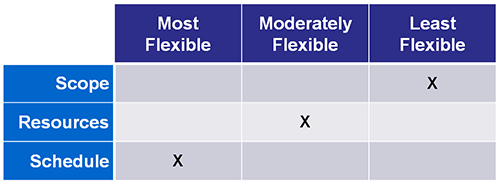Even Hotels Understand Constraints –
Why Can’t My Management Team?
By Vicki Wrona, PMP:
One of the benefits of enrolling in a hotel program is being able to specify preferences. Recently, after making my hotel reservation, I reviewed the options presented to me. What I found was this:
To better accommodate you during your next stay,
please provide us with your room preferences.
What I found interesting about this list is that even hotels understand constraints. You not only get to register your room preferences, you then get to specify which is the most important, just in case not all preferences can be delivered. That is what a flexibility matrix does. First I will explain the matrix and then I will show you one.
I have found the flexibility matrix to be an extremely handy tool for setting expectations and encouraging helpful dialogue early in a process or project. Early, open and productive dialogue is a good practice for anyone managing almost any kind of effort to follow.
Here is how the matrix works. Early in the effort, ask both the customer and the internal sponsor to identify which of the main constraints is the least flexible. The idea here goes back to the old saying, “Good, fast or cheap. Pick any two.” The customer can have the end product good and fast, but it won’t be cheap. Or they can have it fast and cheap but it won’t be good. And so on. While we would like to have it all, it is not realistic. Even the most demanding managers want to deliver successfully, too. They do not want to look bad to their peers or bosses.
As managers, if it appears that all of the parameters outlined for a work effort cannot be met, we need to know where we have some flexibility. Can we take a little longer on the effort, delivering small pieces of the end product in chunks? Can we get a few more people to help speed things up if we are falling behind? Can we adjust the scope of the product we are creating so it can be done on time and within budget? Now we not only know what is expected of us, we can also better manage changes.
Below is an example of a completed Flexibility Matrix. The object of this table is to have one ‘X’ per column. No cheating! It defeats the purpose of this to put more than one ‘X’ under the Least Flexible column.

- Scope is least flexible, and should be delivered as negotiated in the project plan.
- Resources are moderately flexible as there are situations which periodically allow resources to become available. Though it is never assured that more resources can be dedicated to the program, the Sponsor has indicated that the Program Manager should request additional resources when necessary in order to maintain progress.
- Schedule is the most flexible, as long as a good faith effort is shown to produce the end result.
Try this and let me know how it works for you.
 Full Course: Scope Definition and Management (1 day)
Full Course: Scope Definition and Management (1 day)
Click here for our full list of available courses!
Why Can’t My Management Team?





